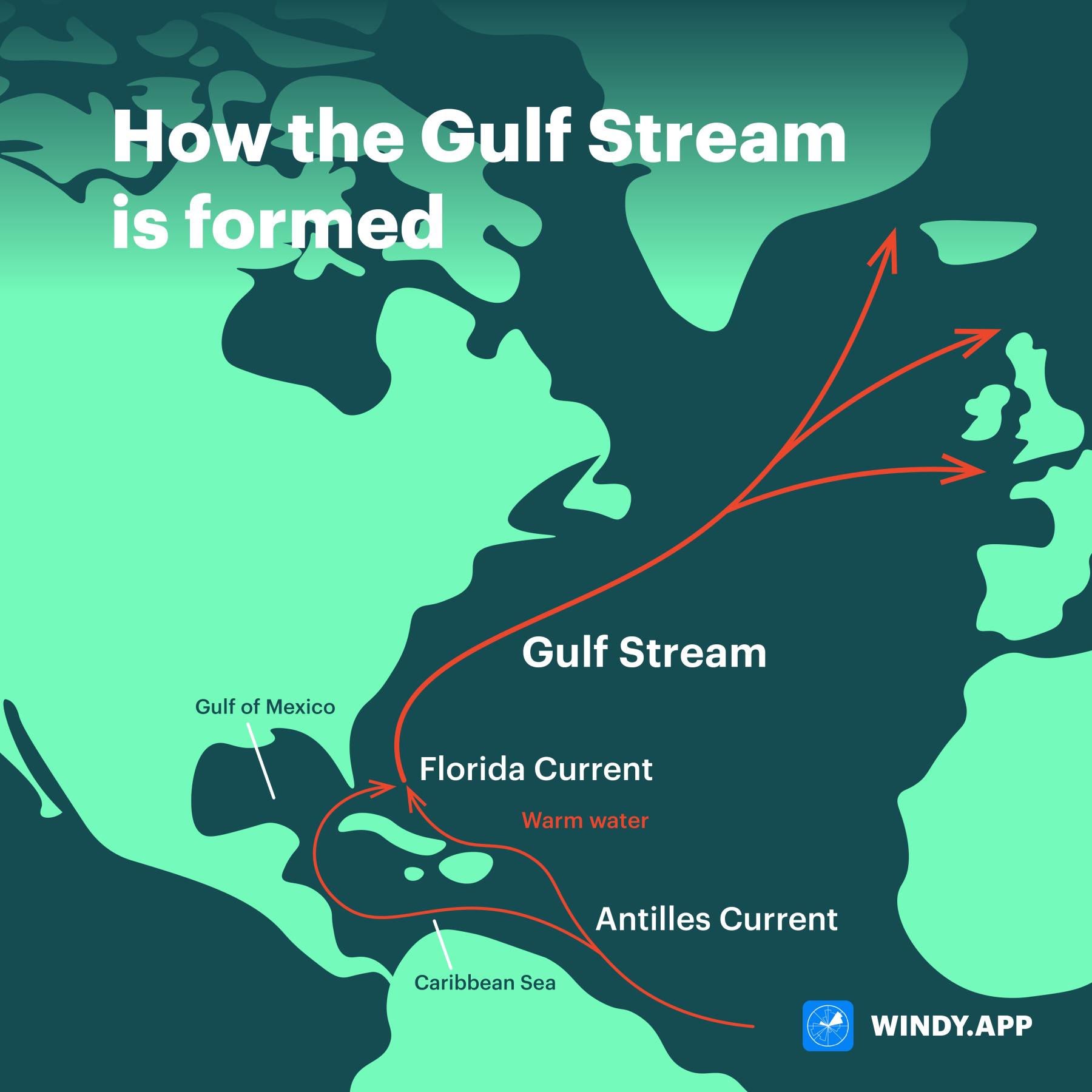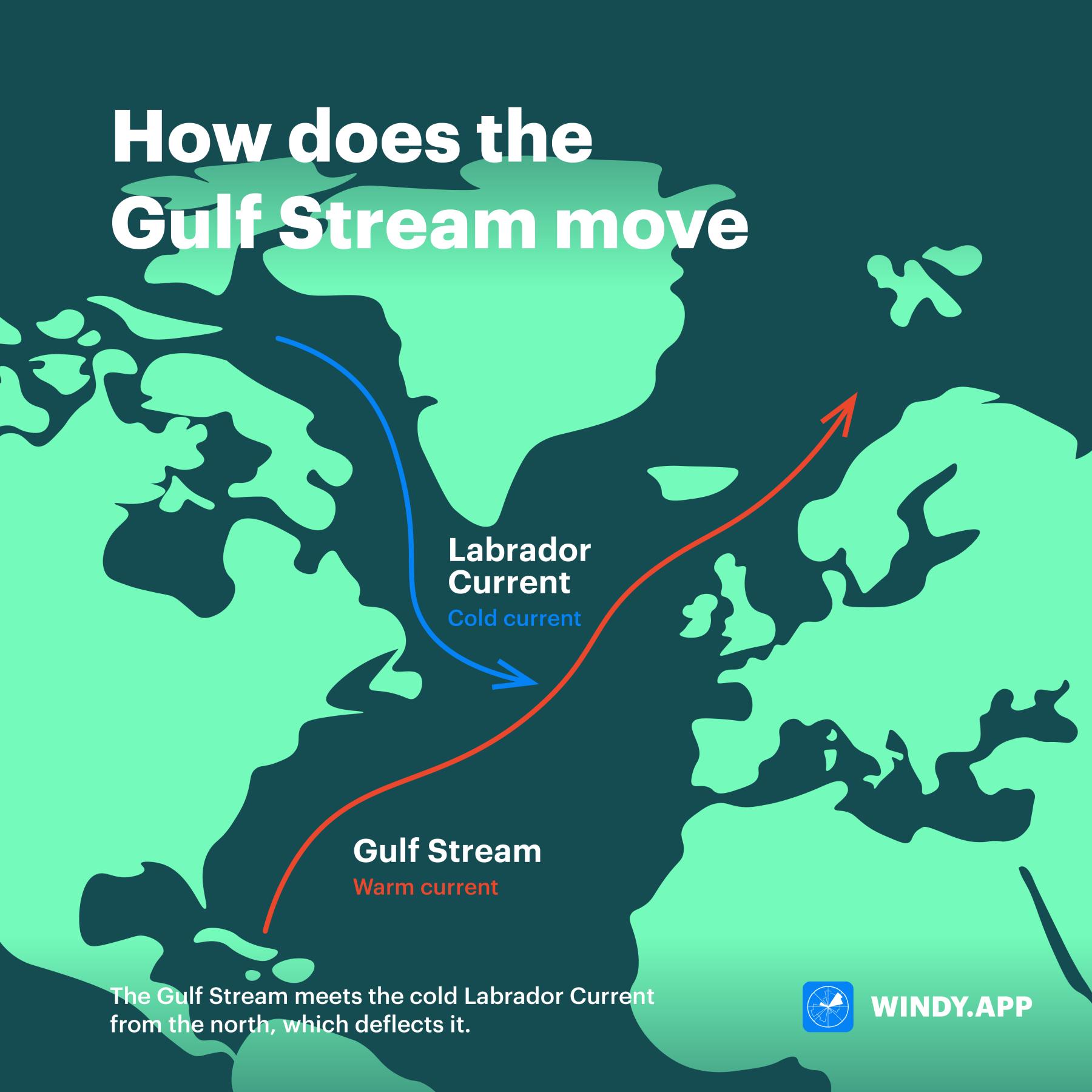
What you should know about the Gulf Stream
The Gulf Stream brings tropical heat to Europe and the North Atlantic. In this new lesson of the Windy.app Meteorological Textbook (WMT) and newsletter for better weather forecasting you will learn more about Gulf Stream and how it formed.
The Gulf Stream carries more water than all the rivers on our planet combined!
Its speed is also worth mentioning: in some places it reaches 2.5 m/s. Usually surface currents move at a speed of less than 1 m/s. The average width of the Gulf Stream is 70-100 km.
How is such a fast warm current formed?
The Gulf Stream = the Florida Current + the Antilles Current
Winds blow along the equator all year long (from east to west) — these are trade winds. When the wind blows above the surface of the ocean, it pulls the top layers of water with it. So there is an excess of water in the Caribbean.
Some of that excess is pushed into the Gulf of Mexico. The depth of the Gulf is small (relative to the ocean), so the water warms up considerably and goes from there to the Atlantic through the Florida Current (so the water flows from the Caribbean Sea and into the Atlantic Ocean). This is how the Florida Current appears.
The other part of the water surplus moves slightly to the north of the Caribbean Sea and Gulf of Mexico, bypassing the Antilles from the north. This stream is called the Antilles Current.
When the Florida and Antilles Currents come together, the Gulf Stream is formed.

How the Gulf Stream is formed. Illustration: Valerya Milovanova / Windy.app
How does the Gulf Stream move?
Originally the Gulf Stream moves north, almost clinging to the east coast of North America, then going into the open ocean. The Gulf Stream then turns east, towards Europe.
There are two reasons for that:
- The Gulf Stream meets the cold Labrador Current from the north, which deflects it (see the picture).
- The Coriolis effect, which deflects all moving objects to the right in the Northern Hemisphere.

How does the Gulf Stream move. Illustration: Valerya Milovanova / Windy.app
It's a little more complicated than that.
Yes, the Gulf Stream is deflected because of the Coriolis effect. But a more complex dependency works here: it isn't just deflection to the right.
There is an effect called the Western Intensification, it is associated with a change in the Coriolis acceleration in latitude (∂F/∂φ). Read more in this book, page 201.
The description of the Coriolis effect is as follows: If a body moves on the surface of the Earth, it always deflects to the right in the Northern Hemisphere and to the left in the Southern Hemisphere.
Rings
The Gulf Stream often forms rings on its way — vortices in the ocean. The current does not always move straight, it can bend. There are more than a dozen vortices with a diameter of about 200 km in the ocean at any given time.
These rings are separated from the main stream and move in the ocean independently at a speed of 3-5 cm/s.
.png)
A satellite image of the Gulf Stream, taken using thermal imaging
A satellite image of the Gulf Stream, taken using thermal imaging. Two rings can be seen to the north and south of the Gulf Stream.
Rings moving north heat up the water, while those moving south cool it down. Yes, the warm Gulf Stream can cool, because moving north, it gradually cools down, and the water is warmer to the south.
The current is warm not because it is warm itself, but because it is WARMER than the surrounding water.
Why does the Gulf Stream cool down along the way?
Part of the Gulf Stream's heat is lost through evaporation. And the Gulf Stream mixes with the cold ocean around it, so it loses most of its heat on its way to Europe.
The Gulf Stream also cools down due to contact with colder air and the fact that branches of the main stream are sometimes formed (e.g. Canary). These branches become new currents and carry away warm water...
Even so, reaching Europe, the Gulf Stream is still warm enough to create an unusually mild climate for those latitudes.
Why will global warming bring cold to Europe?
Some scientists worry that global warming will stop the Gulf Stream from reaching the shores of Europe and the climate will get very cold there. How is that possible?
The warmer it gets on our planet, the more actively the ice will melt. Greenland's glaciers will melt. It will desalinate the adjacent seas, as the water in the glaciers is almost sweet.
How will this affect the behaviour of the Gulf Stream and the climate in Europe?
The Gulf Stream now reaches the shores of Europe, then heading towards Greenland. The tropical water, due to strong evaporation and lack of rainfall in the tropics, has high salinity. Saltier water is heavier, and heavier water always sinks when surrounded by lighter water. The salinity of the Gulf Stream is higher than the salinity of the waters near Greenland, and part of the Gulf Stream there sinks to the bottom while the rest continues to move to northern Europe.
What will change if northern seas desalinate? The Gulf Stream will start sinking to the bottom before it reaches the shores of Europe!
This is not happening now, because the water around the Gulf Stream is quite salty, so it is also quite heavy, and the Gulf Stream is also warmer which makes it lighter.
If ocean water becomes sweeter, the salty, albeit warm, Gulf Stream will immediately be much heavier than the surrounding water mass, and thus will start sinking long before approaching Greenland and Europe. Warm water will go to the bottom, not to Europe. It's a paradox, but global warming could cause the climate in Europe to cool down.
Text: Windy.app team
Illustration: Valerya Milovanova, an illustrator with a degree from the British Higher School of Art an Design (BHSAD) of Universal University
Cover photo: Unsplash
You will also find useful
Latest News
Professional Weather App
Get a detailed online 10 day weather forecast, live worldwide wind map and local weather reports from the most accurate weather models.
Compare spot conditions, ask locals in the app chat, discover meteo lessons, and share your experience in our Windy.app Community.
Be sure with Windy.app.



